Mitrephora fragrans is a species of plant in the family Annonaceae. It is native to Borneo and The Philippines. Elmer Drew Merrill, the American botanist who first formally described the species, named it after its large, fragrant flowers.
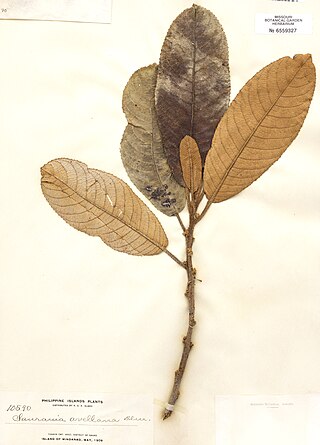
Saurauia avellana is a species of plant in the Actinidiaceae family. It is native to the Philippines. Adolph Daniel Edward Elmer, the American botanist who first formally described the species, named it after the dense covering of hazel-colored downy hair covering the underside of its leaves.

Saurauia clementis is a species of flowering plant in the family Actinidiaceae. It is endemic to the Philippines. Elmer Drew Merrill, the American botanist who first formally described the species, named it after Mary Strong Clemens, the American botanist who collected the specimen that he examined.

Saurauia copelandii is a species of plant in the Actinidiaceae family. It is native to the Philippines. Adolph Daniel Edward Elmer, the American botanist who first formally described the species, named it in honor of Edwin Copeland, another American botanist who collected many botanical samples in the Philippines.
Saurauia glabra is a species of plant in the Actinidiaceae family. It is native to Borneo. Elmer Drew Merrill, the American botanist who first formally described the species, named it after its hairlessness.
Saurauia klemmei is a species of plant in the family Actinidiaceae. It is native to the Philippines. Elmer Drew Merrill, the American botanist who first formally described the species, named it after Wilhelm Klemme, a German forest officer, who collected the specimen Merrill examined from Luzon island in the Philippines.
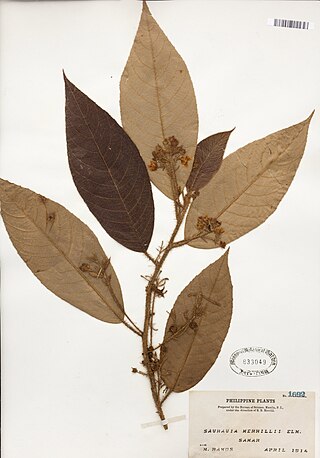
Saurauia merrillii is a species of plant in the family Actinidiaceae. It is native to the Philippines. Adolph Daniel Edward Elmer, the American botanist who first formally described the species, named it in honor of Elmer Drew Merrill, another American botanist.

Saurauia papillulosa is a species of flowering plant in the family Actinidiaceae. It is endemic to the Philippines where it is known as papayang. Elmer Drew Merrill, the American botanist who first formally described the species, named it after the distinctive abundant small bumps, or papillae, on the underside of its leaves.
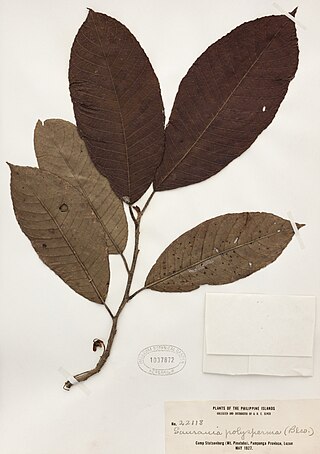
Saurauia polysperma is a species of flowering plant in the family Actinidiaceae. It is endemic to the Philippines. In the Philippines it is also known as tsuke. Francisco Manuel Blanco, the Augustinian friar who first formally described the species, using the basionym Gordonia polysperma, named it after its many seeds.

Saurauia sparsiflora is a species of flowering plant in the family Actinidiaceae. It is endemic to the Philippines. It was discovered on Mount Santo Tomas by Adolph Daniel Edward Elmer, the American botanist who first formally described the species, and named it after the small number, or sparse, flowers in its inflorescences.
Goniothalamus nitidus is a species of plant in the family Annonaceae. It is native to Borneo. Elmer Drew Merrill, the American botanist who first formally described the species, named it after its shining leaves.
Goniothalamus puncticulifolius is a species of plant in the family Annonaceae. It is native to Borneo and The Philippines. Elmer Drew Merrill, the American botanist who first formally described the species, named it after its minutely spotted leaves.
Huberantha flava is a species of plant in the family Annonaceae. It is native to The Philippines. Elmer Drew Merrill the American botanist who first formally described the species, using the basionym Polyalthia flava, named it after its brilliant yellow flowers.
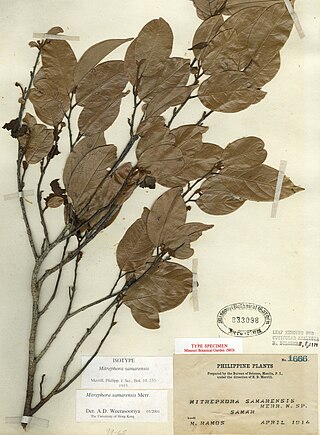
Mitrephora samarensis is a species of plant in the family Annonaceae. It is native to the Philippines. Elmer Drew Merrill, the American botanist who first formally described the species, named it after Samar, the third largest island in the Philippines, where the sample he examined was collected.
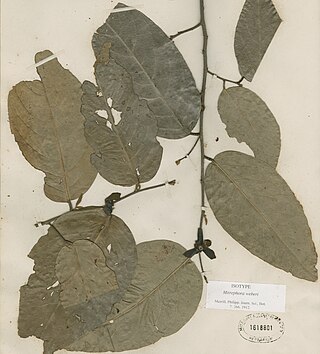
Mitrephora weberi is a species of plant in the family Annonaceae. It is native to The Philippines. Elmer Drew Merrill, an American botanist, first formally described the species and named it after Charles Martin Weber who collected the specimen that Merrill examined.
Mitrephora williamsii is a species of plant in the family Annonaceae. It is native to The Philippines. Charles Budd Robinson, the Canadian botanist who first formally described the species, named it after Robert Statham Williams who collected the specimen that Robinson examined.
Pseuduvaria aurantiaca is a species of plant in the family Annonaceae. It is endemic to New Guinea. Friedrich Anton Wilhelm Miquel, the Dutch botanist who first formally described the species using the basionym Orophea aurantiaca, named it after its orange colored fruit.
Pseuduvaria luzonensis is a species of plant in the family Annonaceae. It is native to The Philippines. Elmer Drew Merrill, the American botanist who first formally described the species using the synonym Orophea luzoniensis, named it after Luzon in the Province of Battan, Philippines where the specimen he examined was collected along the Lamao River.
Pseuduvaria macgregorii is a species of plant in the family Annonaceae. It is native to The Philippines. Elmer Drew Merrill, the American botanist who first formally described the species, named it after Richard MacGregor the Australian ornithologist and plant collector who collected the specimen Merrill examined.
Pseuduvaria philippinensis is a species of plant in the family Annonaceae. It is native to the Philippines. Elmer Drew Merrill, the botanist who first formally described the species, named it after the Philippines where the specimen he examined was collected in the Province of Quezon.









